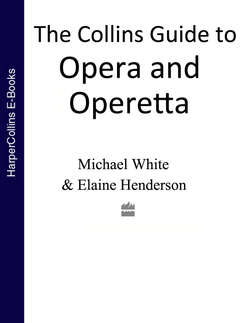Читать книгу The Collins Guide To Opera And Operetta - Michael White - Страница 65
ОглавлениеL’Elisir ďAmore
(The Elixir of Love, The Love Potion)
FORM: Opera in two acts; in Italian
COMPOSER: Gaetano Donizetti (1797–1848)
LIBRETTO: Felice Romani; after Scribe’s libretto for Auber’s Le Philtre
FIRST PERFORMANCE: Milan, 12 May 1832
Principal Characters
Nemorino, a young countryman Tenor
Giannetta, a country girl Soprano
Adina, a rich farm owner Soprano
Belcore, a sergeant Baritone
Dulcamara, a ‘quack’ doctor Bass
Synopsis of the Plot
Setting: A small Italian village; 19th century
ACT I Nemorino is trying desperately, if shyly, to win the heart of rich, beautiful Adina, but he is firmly upstaged by the confident, masterful Belcore, who mocks Nemorino’s efforts. Nemorino has been reading the story of Tristan and Isolde and, like Tristan, forlornly accepts that his only hope of winning his beloved lies in his acquisition of a love potion. Just at that moment Dulcamara and his colourful waggon appear. Nemorino outlines his problem and Dulcamara assures him that he has exactly the same potion that Tristan used. He sells him (for Nemorino’s last coin), a small bottle of Bordeaux wine, with the proviso that the magic takes twenty-four hours to work. Nemorino’s happiness is assured and he settles down to wait for Adina to fall in love with him – only to have his dreams shattered by the news that Belcore’s detachment must leave immediately and he and Adina have decided to marry that very day.
ACT II The wedding feast is under way at Adina’s farm and the happy couple depart to sign the marriage contract. A disconsolate Nemorino is offered another bottle of elixir, this time one that has an instant effect. To pay for the potion Nemorino enlists with Belcore’s regiment. Meanwhile, news has arrived that Nemorino has just inherited a large sum of money and the village girls all flock around him. Nemorino, unaware of his luck, supposes this to be the effect of the elixir. Adina, who has postponed the signing of the contract, learns from Dulcamara that Nemorino has bought the potion and this, together with the fact that he even enlisted so that he could pay for it, touches her very much. Nemorino, seeing a tear in her eye, pours out his heart to her and she, in turn, tells him that she has bought his discharge from the army. The happy couple are united and Dulcamara does a roaring trade in elixirs – proved to bring not only love but money too! Even the rejected Belcore accepts the situation philosophically, and comforts himself with the thought that the world is, after all, full of girls.
Music and Background
This ‘male Cinderella’ opera may be full of stock comic characters, but their music rises above the predictable and blossoms into some of the most engaging melodies of the bel canto repertoire. Essentially a tenor’s opera in which Nemorino inevitably steals the show with his romanza ‘Una furtiva lagrima’ (oddly but effectively accompanied by solo bassoon), it nonetheless offers all the principal characters their moment, and even allows them some opportunity for character development. Not all bel canto operas bother with such things.
Highlights
‘Una furtiva lagrima’ in Act II is the turning point of the opera (when Nemorino realises that Adina loves him) and the moment everybody waits for. But Nemorino’s opening Act I cavatina ‘Quanto è bella’ is almost equally famous; Dulcamara has an irresistible song of sales patter ‘Udite, udite’; and the duet ‘Esulti pur la barbara’, when Adina finds Nemorino drinking the potion, is the spirited high point of Act I.
Did You Know?
In Donizetti’s lifetime, this was his most popular score.
Recommended Recording
Joan Sutherland, Luciano Pavarotti, English Chamber Orchestra/Richard Bonynge. Decca 414 461-2. A young Pavarotti, captured in his prime in 1971.
